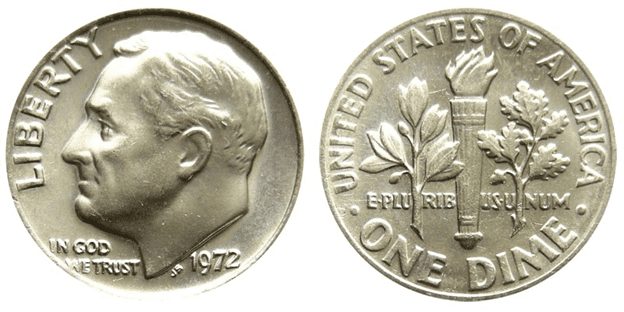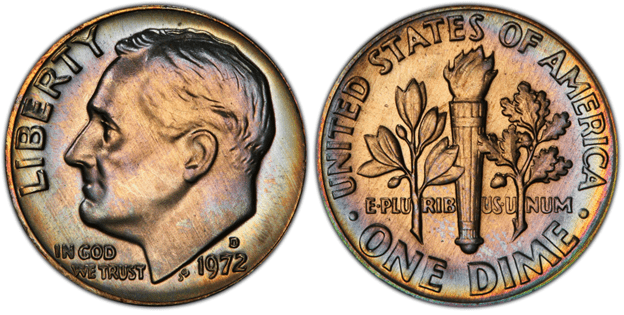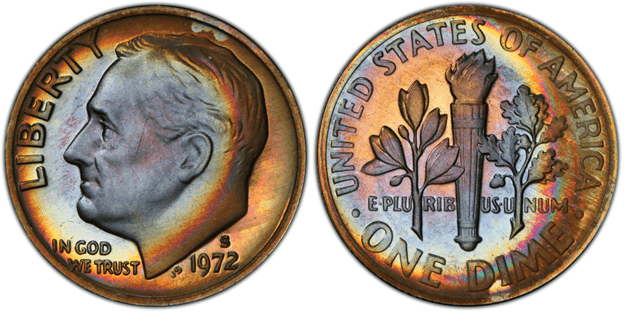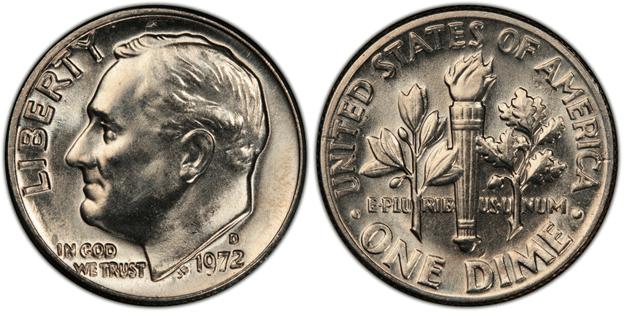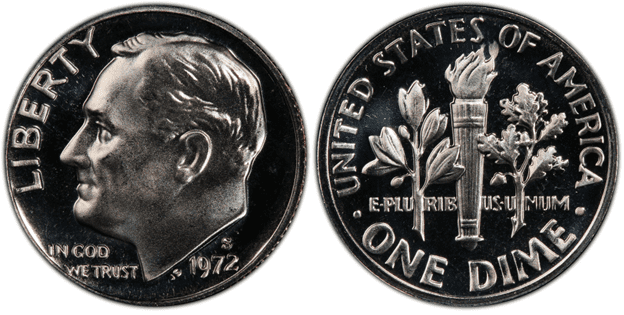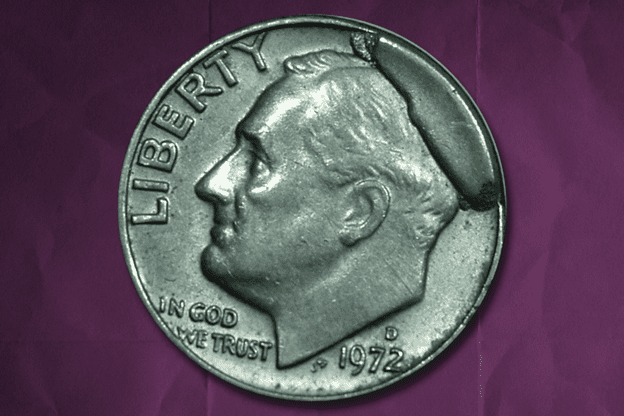What Is A 1972 Dime Made Of?
The United States Mint produced the Roosevelt Dime in 1972. This coin is made of a clad material, which means that the inner core is solid copper and the outer layer is a combination of copper and nickel (91.67 percent Copper – 8.33 percent Nickel).
This means that the 1972 Dime doesn’t have any silver content, meaning that barring a unique scenario, (such as errors or perfect condition), these coins will be worth their face value.
The inscription “Liberty, In God We Trust, and the year, together with the designer’s JS initials” can be found on the coin’s obverse. “United States of America, E Pluribus Unum, One Dime” is written on the coin’s reverse.
The reverse, or back side, of the coin, depicts a torch in the middle with two branches around it. The obverse, or front side, of the coin, displays President Franklin D. Roosevelt.
By the time the Roosevelt dime went into production in 1972, the design had reached the 25-year minimum service life that was legally required.
The four-term president was an appropriate replacement for Weinman’s Winged Liberty design in 1946, and the opinion of the longest-serving American president remained positive as the generation he presided over as it weathered the Great Depression and World War II into its later years.
Despite being a beloved person, Franklin D. Roosevelt and his government were not immune to criticism.
Numismatists may bemoan his 1933 Executive Order, which ordered the recall of millions of gold pieces, but when taken in a larger perspective, it was the Emergency Banking Act of March 1933 that really decided whether or not the United States would forsake the gold standard.
As previously established, 1972 dimes contain no silver. The majority of the 90% silver Roosevelt dimes produced between 1946 and 1964 were no longer circulated in the economy as of 1972.
Along with sorting and removing silver coins from the federal stockpile, the United States Mint also removed the more valuable silver dimes from circulation by individuals and maybe institutions.
Since 1965, the Business strike clad Roosevelt dimes have been struck in Philadelphia, and since 1968, they have been struck in Denver.
Before the fiscal year 1972, the planchets were bought under contract; after that year, the Mint established the capacity to make its own clad coin strip. The first coinage produced using the sandwich metal produced by the mint was dimes and quarters.
1972 was a pretty busy year for the USA. The Pioneer 10 spacecraft, which will be the first man-made satellite to depart the solar system, is launched from Cape Kennedy while Mariner 9 transmits images from Mars. In the United States, The Godfather opens in theatres. Perhaps most notably, the Watergate Scandal began in 1972.
1972 Dime Varieties
1972 Dime With No Mint Mark
Year: 1972
Face Value: $0.10
Composition: 91.67% Copper and 8.33% Nickel
Total Weight: 2.27g
Diameter: 17.91mm
Thickness: 1.35mm
Edge: 115 Reeds
Minted in: Philadelphia
Quantity Minted: 431,540,000

photo source: www.usacoinbook.com
Coins lacking a mint mark are struck at the Philadelphia mint, who have never added a mint mark to their coins.
The 1972 dime’s strike quality was poor. The master dies used to strike dimes had significantly worn out by 1972.
When compared to the Denver Mint’s output, the Philadelphia Mint was similarly not known for producing exceptionally high-quality coins in the 1970s. The W in the motto, the detail of Roosevelt’s hair, and the softness of the bands of the torch on the coin’s reverse are all hallmark characteristics of the 1972 dime.
Due to the Philadelphia dime’s inherent quality, fully-struck examples with Full Bands visible on the reverse are uncommon.
1972 D Dime
Year: 1972
Face Value: $0.10
Composition: 91.67% Copper and 8.33% Nickel
Total Weight: 2.27g
Diameter: 17.91mm
Thickness: 1.35mm
Edge: 115 Reeds
Minted in: Denver
Quantity Minted: 330,290,000

photo source: www.pcgs.com
1972 S Dime (Proof)
Year: 1972
Face Value: $0.10
Composition: 91.67% Copper and 8.33% Nickel
Total Weight: 2.27g
Diameter: 17.91mm
Thickness: 1.35mm
Edge: 115 Reeds
Minted in: San Francisco
Quantity Minted: 3,260,996

photo source: www.pcgs.com
1972 Dime Full Band

photo source: www.pcgs.com
Because of the inherent low-quality striking of most of the 1972 Dimes, perfectly struck coins from this year are highly sought after.
Some business-strike Roosevelt dimes with full separation on the two sets of bands crossing the torch on the reverse are designated as Full Bands (FB) after the number grade.
This separation of the bands indicates that the dime has been struck to a high quality.
1972 S Cameo Proof

photo source: www.pcgs.com
If a proof coin’s field has a mirror-like surface, and its devices have a frosted surface, it is considered a cameo coin.
Prior to 1971, proof coins were produced in a way that only the first 100 coins had a cameo contrast effect but this changed in 1972, meaning that while sought after, these 1972 proof examples aren’t exceptionally rare.
If the contrast between the surface and devices is high, then the coin is known as a ‘Deep Cameo’ such as seen in the example below. These coins are even more sought after than the cameo varients.
1972 Dime ‘Cud’ Error

photo source: www.pcgs.com
This 1972 dime with a cud error sold for $120 at auction. A cud is a particular kind of die flaw where the coin has elevated metal.
This accidental “bump” in the coin, which differs from a die crack in that it results from a dent or gouge in the die, allows the coin to fill in the gap during the minting process.
How Much Is A 1972 Dime Worth Today?
The 1972 Dime has a melt value of only $0.024, which means that its face value is worth 5 times more than its melt value, as any silver content has been removed.
This indicates that the inherent metal worth of 1972 Dimes is not their true value; rather, their true value is as a collectable.
The anticipated values for normal strike 1972 dimes in various grades are listed below.
| Coin | VG-8 | F-12 | VF-20 | EF-40 | AU-55 | MS-63 | MS-65 |
| 1972 P Dime | $0.12 | $0.12 | $0.12 | $0.12 | $0.15 | $0.70 | $9.00 |
| 1972 D Dime | $0.12 | $0.12 | $0.12 | $0.12 | $0.15 | $0.70 | $9.00 |
| 1972 S Dime | $0.44 | $0.66 | $0.88 | $1.10 | $1.32 | $1.54 | $1.76 |
How Does The Grading System Work?
The Sheldon Scale is used by numismatists to provide a numerical value to coins. The Sheldon Scale goes from poor (P-1) to perfect mint state (P-1) (MS-70). Coins were originally evaluated using words to reflect their condition (Good, Fair, Excellent, Etc.). Unfortunately, coin collectors and dealers had different ideas about what each of these terms represent.
Professional numismatists joined together in the 1970s and established CoinGrading standards. These numismatists now assign grades at key places on the seventy-point scale, using the most regularly utilized numeric points in conjunction with the original adjective grade. The following are the most common coin grades:
-
-
- (P-1) Poor – Indistinguishable and probably damaged; if used, must have a date and mintmark; otherwise, rather battered.
- (FR-2) Fair – Nearly smooth, but without the damage that a coin graded Poor often possesses. The coin must have enough detail to be identified.
- (G-4) Fair – Inscriptions have merged into the rims in some areas, and important elements have been mostly erased.
- (VG-8) Very Good- A little weathered, but all of the primary design elements are visible, albeit faintly. There is little if any, central detail left.
- (F-12) Good – The item is very worn, yet the wear is even, and the overall design details stand out clearly. Rims are almost completely isolated from the field.
- (VF-20) Very Fine – Moderately weathered, with some finer features still visible. The motto or all letters of LIBERTY are readable. Both sides of the coin have entire rims that are separated from the field.
- (EF-40) Extremely Fine – Gently used; all gadgets are visible, and the most important ones are bold. The finer details are bold and clear, however, light wear may be seen.
- (AU-50) Uncirculated – Slight evidence of wear on the coin’s design’s high points; may have contact marks; eye appeal should be adequate.
- (AU-58) Uncirculated Choice – Slight traces of wear, no severe contact marks, almost full mint shine, and great eye appeal.
- (MS-60) Mint State Basal – Strictly uncirculated; no indication of wear on the coin’s highest points, but an unsightly coin with reduced luster, visible contact marks, hairlines, and other flaws.
- (MS-63) Mint State Acceptable – Uncirculated, but with contact scratches and nicks, little reduced shine, but otherwise appealing appearance. The strike is weak to average.
- (MS-65) Mint State Choice – Uncirculated with great mint shine, very little contact blemishes, and exceptional eye appeal. The strike is unusually severe.
- (MS-68) Mint State Premium Quality – Uncirculated with superb luster, no obvious contact marks to the naked eye, and exceptional eye appeal. The strike is quick and appealing.
- (MS-69) Almost Perfect Mint State – Uncirculated with perfect brilliance, a sharp and appealing strike, and extremely good eye appeal. A near-perfect coin with minor imperfections in the planchet, strike, and contact markings (seen only under 8x magnification).
- (MS-70) Mint State Perfect – Under 8x magnification, there are no tiny imperfections discernible; the strike is crisp, and the coin is perfectly centered on a beautiful planchet. Rarely seen on a coin, this coin is bright and whole, with original luster and exceptional eye appeal.
-
Where To Buy Or Sell 1972 Dimes?
A 1972 dime found in change carries almost no numismatic premium, yet an unwary bidder can end up paying $1 for one on auction websites like eBay.
Coin dealers won’t stock the date in circulated grades, and even if they were provided, they wouldn’t buy them.
A collector can purchase a loose uncirculated specimen for the same $1, either from a roll or a Mint Set.
A certified example in mint condition will be less expensive for a collector to purchase than having the coin graded. For a gem example without the FB/FT indication, budget $5 to $10.
Due to the rarity of the FB/FT Gem coins, public auction data is too old to estimate their current market worth. A coin this rare might fetch between $500 and $800, according to PCGS CoinFacts, where one example sold in PCGS MS66FB in 2017 for $423.
The coin with the highest population graded by any service is graded MS67+FT. Given the difficulty in locating a similar specimen in the wild, PCGS CoinFacts’ $2,750 asking price seems fair.
FAQs
Is the 1972 dime supposed to have a mint mark?
Dimes minted in Denver and San Francisco will have mint marks, while dimes struck in Philadelphia will have no mint mark.
Are dimes with no mint mark valuable?
As mentioned dimes without a mint mark were minted at Philadelphia which is one of the most common mints in the USA.
How much is a 1972 gold dime worth?
The first person to obtain a piece of this gold dime won a fortune for it as part of an advertising promotion. After the authenticity of these was confirmed, awards were also handed to the others who also found these gold dimes and turned them in.
The first person to turn in his find received $25,000, while the others each received $1,000.
Because these coins are so rare there is no up-to-date auction valuation and theoretically, a collector in possession of their coin can name their price.

